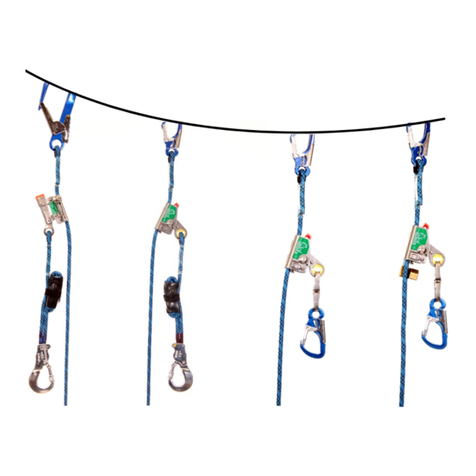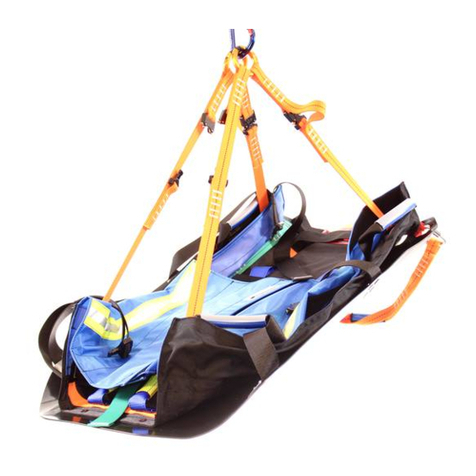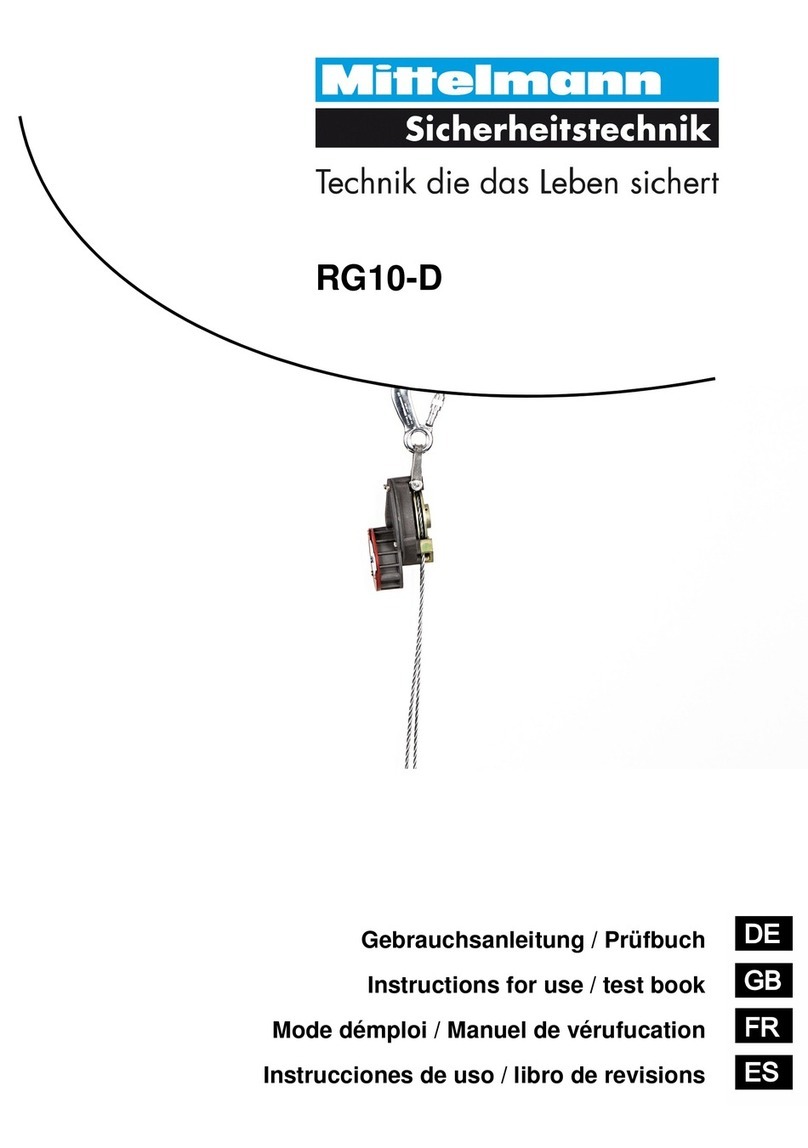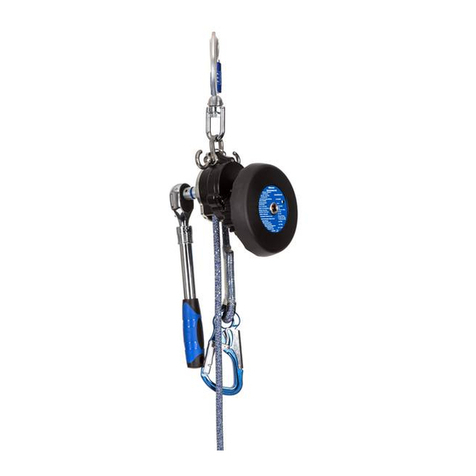3.3 Hubfunktion
Für das Heraufziehen einer Person von einem tiefer- zu einem höhergelegenen Ort, muß das
Rettungshub- und Abseilgerät mit dem am Gerät befindlichen Karabinerhaken an einem
Anschlagpunkt nach EN 795 sicher befestigt werden. Hubknarre abnehmen. Den am kurzen
Abfahrseilende befindlichen Rettungsgurt mit dem Abfahrseil nach unten ablassen. Hierfür muß
das Seil durch das Gerät durchgezogen werden. Der Umschalthebel der Halteknarre muß dabei
in Richtung langes einlaufendes Seil zeigen. Die hochzuziehende Person legt den am Abfahrseil
befindlichen Rettungsgurt an. Für den Hubvorgang den Umschalthebel der Halteknarre in
Richtung lasttragendes Seilende umschalten. Hubknarren aufstecken. Der Umschalthebel der
Hubknarren muß in Richtung loses Seilende zeigen. Hubvorgang beginnen.
Zur Vereinfachung der Schaltstellungen der Umschalthebel an der Halte- und den Hubknarren
sind diese mit rot und gelb gekennzeichnet. Je nach Hub- bzw. Abseilrichtung immer alle Schalter
entweder auf gelb oder alle Schalter auf rot stellen. Die Hubknarren und die Adapter für die
Hubknarren sind blau und rot markiert. Rote Hubknarre immer in roten Adapter und blaue
Hubknarre immer in blauen Adapter.
3.4 Rettung einer hilflos im Verbindungsmittel hängenden Person
Achtung: Arbeitshandschuhe erforderlich !
Das Rettungshub- und Abseilgerät mit dem am Gerät befindlichen Karabinerhaken an einem
geeigneten Anschlagpunkt nach EN 795 sicher befestigen.
Den Karabinerhaken des kurzen Seilendes in die Rückenöse des Auffanggurtes der zu rettenden
Person einhaken und sichern. Der Umschalthebel der Halteknarre muß in Richtung des kurzen in
die Rückenöse eingehakten Seilendes zeigen. Die Umschalthebel der Hubknarren müssen in
Richtung loses Seilende geschalten werden. Mit den Hubknarren die zu rettende Person soweit
anheben, daß diese aus dem Verbindungsmittel gelöst werden kann.
Das Abseilen der Person erfordert das Umschalten aller Knarren. Auch hier gilt wieder, je nach
Hub- bzw. Abseilrichtung alle Schalter entweder auf gelb oder alle Schalter auf rot stellen.
Achtung: Unter Last können und dürfen die Knarren nicht umgeschaltet werden.
Zum Umschalten muß als erstes die Halteknarre und anschließend die Hubknarren entlastet
werden. Hierzu ist wie folgt vorzugehen: Mit einer Hubknarre die Last anheben und mit dieser
auch die Last halten. Dadurch wird die Halteknarre entlastet und kann umgeschaltet werden.
Achtung: Die Last weiter mit der Hubknarre halten.
Beim LiftEvac 2K die zweite Hubknarre ebenfalls umschalten. Bei Bedarf kann diese durch
betätigen des Auswurfknopfes vom Gerät abgenommen werden. Jetzt das unbelastete Seil in den
offenen Haken einlegen, fest nach unten ziehen und straff halten. Die Hubknarre mit der die Last
gehalten wird, kann jetzt langsam entlastet und ebenfalls umgeschaltet werden, oder durch
Betätigung des Auswurfknopfes vom Gerät abgenommen werden. Dabei muß die Last mit dem
Seil gehalten werden. Es erfolgt also eine Lastübergabe von der Hubknarre auf das straff nach
unten zu haltende Seil. Um den Abseilvorgang zu beginnen das Seil langsam durch die Hand
gleiten lassen und los lassen. Die Abseilgeschwindigkeit wird durch eine Fliehkraftbremse
automatisch geregelt. Bei der Rettung eines Verunfallten aus einer Steigleiter ist es oft
erforderlich, den Vorgang des Abseilens, zusätzlich von Hand mit zu steuern. Dazu läßt der Retter
das nach oben laufende Seil durch seine Hand gleiten und kann damit die Abseilgeschwindigkeit
exakt steuern und den Verunfallten so an möglichen Hindernissen langsam vorbeiführen.
3.5 Rettung durch Heranfahren des Retters an eine zu rettende Person
Mit dem Abseil- und Rettungshubgerät LiftEvac ist es auch möglich, daß der Retter direkt mit dem
Gerät an die zu rettende Person heranfährt, diese anhängt, gegebenenfalls sich selbst und die zu
rettende Person anhebt um z.B. das Verbindungsmittel der zu rettenden Person zu lösen und
dann gemeinsam mit dieser nach unten abfährt.
Diese Rettung darf nur von Personen durchgeführt werden, die in die sicheren Benutzung speziell
dieser Anwendung unterwiesen sind und die entsprechenden Kenntnisse haben.
4. Wartung, Lagerung, Transport und Instandsetzung
Nach dem Einsatz Abseilgerät und Abfahrseil gegebenenfalls reinigen. Reinigung mit
Feinwaschmittel und reichlich Wasser (40°C).
Wenn es beim Einsatz oder beim Reinigen naß geworden ist trocknen.

































